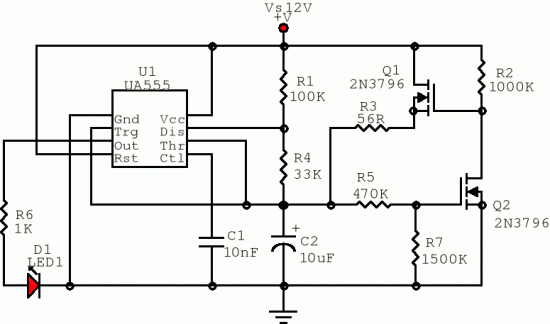555 Pulse Generator
Description:
A 555 pulse generator circuit with a difference, the initial pulse is tailored by additional circuitry to match the duration of subsequent pulses.
Notes:
The NE555 and the First Pulse
The first positive pulse from a classic 555-based oscillator is always 1.6 times longer than the following pulses. The difference is caused by the fact that only during the first cycle C2 starts charging up from 0 V. This is generally not a problem, but sometimes this first pulse just should be the same length as the rest - at least approximately.
The picture shows the oscillator and an addition to it (everything to the right from the Vs-Gnd axis) that can solve the problem. Immediately after switch-on, C2 is empty and the voltage on the gate of Q2 is low. Q2 is off and it makes C2 charge up very quickly through Q1 and R3 until it reaches just below Vs/3. Then Q2 turns on, Q1 turns off, and the classic circuit continues to charge and discharge C2 relatively slowly between 2Vs/3 and Vs/3. As the voltage on C2 never again drops below Vs/3, Q2 now conducts all the time and Q1 is permanently off.
A MOSFET with a lower D-S resistance would charge up C2 even quicker.
The component values may be critical. For best results, the R5/R7 voltage divider should turn Q2 on when C2 is charged up to just a little below Vs/3. This point is set by the R5/R7 ratio. But if the value of R5 is too high or if R7 is too small (depending on the supply voltage and the G-S threshold voltage of Q2), the oscillator may not work at all. The sum of R5 and R7 should be as high as possible in order to minimize the influence on the main part of the circuit after the first pulse.

